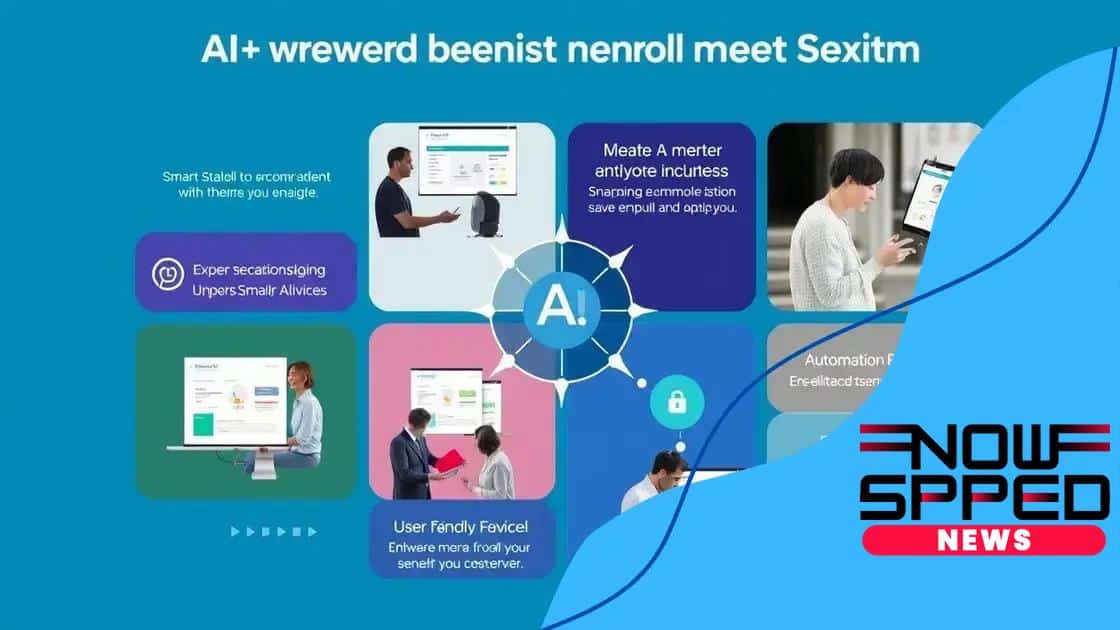AI-powered benefits enrollment systems transform experiences

AI-powered benefits enrollment systems enhance employee experiences by providing personalized recommendations, mobile access, and robust security measures, streamlining the process of managing employee benefits effectively.
AI-powered benefits enrollment systems for employees are changing how we access and manage health benefits. With streamlined processes and personalized options, it’s easier than ever to make informed choices. Curious to see how this impacts your workplace?
What are AI-powered benefits enrollment systems?
AI-powered benefits enrollment systems are innovative tools designed to simplify the process of selecting employee benefits. These systems use artificial intelligence to create a more personalized and efficient experience for both employers and employees.
Employers can benefit from these systems by offering a tailored approach to benefits, ensuring employees receive options that best suit their needs. When we think about the various benefits available, such as health insurance, retirement plans, and wellness programs, the complexity can be overwhelming. This is where AI comes in, helping to streamline choices and reduce the stress involved.
Key Features of AI-powered Systems
AI-powered systems offer several features that enhance the enrollment experience:
- Personalization: These systems tailor benefit recommendations based on employee data and preferences.
- Efficiency: By automating tedious processes, AI can speed up enrollment times significantly.
- Accessibility: Employees can access information anytime, making it easier for them to make informed decisions.
In addition to these features, the use of data analytics helps employers understand the trends and preferences of their workforce. This can lead to better engagement and satisfaction with the benefits offered. Furthermore, the systems can also assist in compliance with regulations, ensuring that organizations meet legal requirements effortlessly.
With the integration of chatbots and virtual assistants, employees now have a support system available 24/7. They can ask questions and receive instant responses, making the process even more user-friendly. As these technologies continue to evolve, the experience for employees looking for the right benefits will only improve.
The Importance of User Experience
User experience plays a critical role in the success of these systems. A seamless interface ensures that employees can easily navigate and understand their options. Feedback from users is vital for continuous improvements, allowing the systems to evolve based on real user interactions.
AI-powered benefits enrollment systems are revolutionizing how organizations manage employee benefits. As more companies adopt these technologies, we can expect to see a shift towards greater employee empowerment and satisfaction in their benefits choices.
How do these systems improve employee experiences?
AI-powered benefits enrollment systems significantly improve employee experiences by simplifying the entire process of selecting benefits. With so many options available, it can often feel overwhelming for employees to navigate through the choices. These systems step in to provide guidance based on individual profiles and preferences.
One major improvement these systems offer is increased personalization. By analyzing data, they recommend benefits that align closely with employees’ needs. This targeted approach not only saves time but also ensures that employees are making choices that truly benefit them.
Enhanced Accessibility
Accessibility is another key area where these systems excel. Employees can access their benefits information at any time, using any device. This convenience allows for better decision-making, as employees don’t feel rushed or pressured to enroll within a limited time frame.
- Real-time updates: Changes to benefits or new offerings are communicated instantly.
- User-friendly interfaces: Simplified designs make navigation easy for everyone.
- 24/7 support: Virtual assistants provide help whenever needed.
Furthermore, the integration of chatbots enhances the experience by allowing employees to ask questions and receive prompt answers. This feature reduces the anxiety that often comes with choosing benefits, making the process feel much less daunting.
Another aspect is the educational resources provided by these systems. Many incorporate videos and articles that explain complex benefits options clearly. This added support helps employees feel more confident in their decisions. Imagine making choices with all the information right at your fingertips. That’s what these AI systems aim to provide.
Improving Engagement
By promoting a seamless experience, these systems enhance employee engagement. When employees feel accommodated and supported in their benefits decisions, they are more satisfied. This satisfaction can lead to improved retention and productivity in the workforce.
AI-powered benefits enrollment systems are revolutionizing the way employees interact with their benefits, making it easier and more intuitive than ever before. As businesses recognize this shift, the focus on employee experience will continue to grow, ultimately benefiting both employees and employers alike.
Key features that enhance enrollment processes

Key features of AI-powered benefits enrollment systems play a vital role in improving the overall efficiency and effectiveness of the enrollment process. These features are designed to eliminate confusion and streamline decision-making for employees.
One significant feature is the use of smart recommendations. These systems analyze data to suggest benefits that align perfectly with an employee’s personal situation. As a result, employees receive tailored options that meet their unique needs.
Automation and Efficiency
Another important aspect is the automation of repetitive tasks. By automating paperwork and data entry, the systems significantly reduce the workload for both HR professionals and employees. This automation not only saves time but also decreases the chance of errors that can occur during manual entry.
- Seamless integration: These systems can integrate with other HR technologies, making data sharing easier.
- Real-time updates: Employees receive updates about their benefits instantly.
- Easy navigation: User-friendly interfaces help employees find what they need quickly.
Moreover, these systems provide accessible resources like FAQs and videos that educate employees about different benefits. This education is crucial in empowering them to make informed decisions. With resources available at their fingertips, employees can explore options without feeling rushed.
Additionally, the incorporation of analytics helps employers track enrollment trends and employee satisfaction. This data can inform future benefit offerings, ensuring they are aligned with what employees truly want and need. The feedback loop created by these analytics allows for continuous improvement of the enrollment process.
Improved Communication
Effective communication is also enhanced through these systems. Employees can use built-in chat features to ask questions or seek help at any time. This support ensures that employees feel confident in their choices and reduces anxiety during the enrollment period.
Ultimately, the combination of smart recommendations, automation, and accessible resources creates a more manageable and engaging enrollment experience for employees. As companies adopt these key features, they foster a culture of involvement and empowerment that benefits everyone.
Challenges and considerations in implementing AI solutions
Implementing AI solutions in benefits enrollment systems comes with its set of challenges. While the advantages are numerous, organizations must be prepared to navigate potential hurdles during the adoption phase.
One significant challenge is the integration of AI technology with existing systems. Companies often use several platforms for HR, payroll, and benefits, making it crucial to ensure compatibility. A seamless integration can be complex and requires thorough planning to avoid disruptions.
Data Privacy and Security
Data privacy is another critical concern when implementing AI solutions. Organizations collect sensitive employee information, and it is essential to protect this data from breaches. Compliance with regulations like GDPR or HIPAA is mandatory, demanding that companies ensure robust security measures are in place.
- Regular audits: Conducting audits helps identify vulnerabilities in security.
- Data encryption: Protect sensitive information through encryption methods.
- Employee training: Ensuring staff are aware of data privacy policies minimizes risks.
Another aspect to consider is the initial cost of implementing AI solutions. Although these systems can save costs in the long run, the upfront investment can be a barrier for some businesses. Organizations need to weigh potential savings against the cost of software, hardware, and training.
Furthermore, there is a learning curve associated with adopting new technology. Employees may require time and training to become comfortable using AI-powered systems. During this transition period, it is vital to provide adequate support to ensure a smooth experience for everyone involved.
Keeping Up with Changes
The technological landscape is ever-evolving. Companies must stay current with advancements in AI and trends in employee benefits to maintain a competitive edge. This continuous education demands resources and commitment, which can challenge smaller organizations.
Despite these challenges, addressing them head-on can lead to improved systems and better outcomes for employees. Companies that approach the implementation thoughtfully will likely see significant returns on their investments in AI-powered benefits enrollment.
Future trends in benefits enrollment technology
The future of benefits enrollment technology is exciting and full of potential. As advancements in artificial intelligence and other technologies continue to evolve, we can expect to see significant changes in how employees interact with their benefits.
One major trend is the rise of personalized experiences. Companies will use data analytics and AI to offer tailored recommendations that suit the specific needs of each employee. Instead of a one-size-fits-all approach, employees will receive options curated just for them, enhancing their engagement and satisfaction with the benefits.
Increased Use of Mobile Platforms
Another trend is the shift towards mobile platforms. More employees are using smartphones and tablets for everyday tasks, including managing their benefits. Benefit enrollment solutions that offer strong mobile capabilities will become increasingly important. This move towards mobile solutions allows for on-the-go access, making it easier for employees to enroll and make changes wherever they are.
- Interactive interfaces: Enhanced user interfaces will simplify navigation and enhance user experience.
- AI-driven chatbots: Real-time assistance available 24/7 through chatbot technology will be more common.
- Seamless integration: These platforms will increasingly integrate with other HR tools, ensuring a smooth flow of information.
Moreover, as companies focus on attracting top talent, they will invest in technology that enhances employee benefits communication. Virtual workshops and interactive webinars will provide employees with information about their options, helping them make informed decisions.
Data Security and Privacy Measures
Data security will also see advancements. As the amount of personal information grows, technology must prioritize protecting employee data. Enhanced security protocols, like biometric verification and advanced encryption, will become standard to safeguard sensitive information.
Lastly, the trend towards continuous feedback loops will likely grow. Employers will want to know how well their benefits are meeting employee needs. By using technology to survey employee satisfaction regularly, organizations can adapt their offerings based on feedback, thereby catering better to their workforce.
The evolution of benefits enrollment technology promises a more personalized, accessible, and secure experience for employees. Companies that embrace these future trends will undoubtedly foster greater satisfaction and engagement among their workforce.
The advancements in AI-powered benefits enrollment systems are reshaping how employees access and manage their benefits. With personalized recommendations, enhanced accessibility, and increased automation, these systems improve the overall experience for users. By addressing challenges like data privacy and ensuring seamless integration, organizations can effectively adopt these technologies. As we look to the future, trends like mobile solutions, interactive resources, and robust security measures will further enhance employee engagement. Embracing these changes is essential for companies aiming to cultivate a satisfied and productive workforce.
FAQ – Frequently Asked Questions about AI-powered Benefits Enrollment Systems
How do AI-powered benefits enrollment systems personalize employee experiences?
These systems analyze employee data to recommend benefits tailored to individual needs, making the selection process more relevant and efficient.
What are the security concerns associated with AI in benefits enrollment?
Organizations must ensure strong data protection measures, such as encryption and audits, to safeguard sensitive employee information from breaches.
Why is mobile access important for employee benefits enrollment?
Mobile access allows employees to manage their benefits conveniently from anywhere, promoting better engagement and timely decision-making.
How can companies ensure effective implementation of AI solutions?
Companies should plan for integration, invest in employee training, and continuously gather feedback to adapt their systems to better meet user needs.





